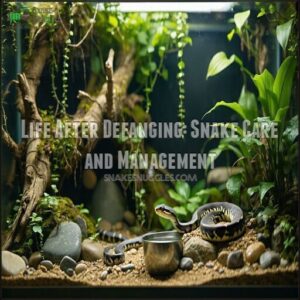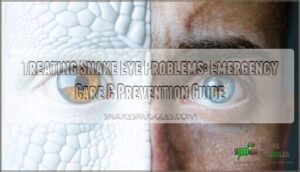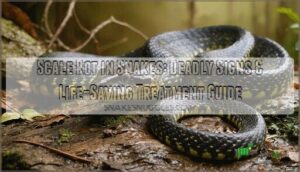This site is supported by our readers. We may earn a commission, at no cost to you, if you purchase through links.
 Defanging a snake involves removing or altering its fangs to prevent venom injection, but it causes serious harm.
Defanging a snake involves removing or altering its fangs to prevent venom injection, but it causes serious harm.
Without fangs, the snake struggles to hunt or eat properly, often leading to malnutrition. The procedure itself is painful and can cause infections, long-term health issues, or even death.
While some think it’s a safety measure, it’s neither humane nor practical—fangs naturally regrow, making it a temporary fix at best.
Venomous snakes also rely on their fangs for survival in the wild, meaning defanging jeopardizes both their health and quality of life. Understanding alternatives can guarantee safety without harming the snake.
Table Of Contents
- Key Takeaways
- Defanging Snakes: What Happens Next
- The Defanging Process Explained
- Risks and Consequences of Defanging
- Fang Regeneration and Replacement
- Alternatives to Defanging Snakes
- The Ethics of Defanging Snakes
- Defanging at Home: Risks and Dangers
- Life After Defanging: Snake Care and Management
- Frequently Asked Questions (FAQs)
- What happens if you Fang a snake?
- Can You Defang snakes?
- What happens if a snake is defanged?
- What happens if a snake bites?
- What happens when a snake breaks its fangs?
- How do you know if a snake is poisonous?
- What happens when a snake gets defanged?
- Is it ethical to defang a snake?
- Can you permanently devenom a snake?
- How to humanely remove a snake?
- Conclusion
Key Takeaways
- Defanging harms a snake by causing pain, infections, and making it hard for it to hunt or eat, which can lead to malnutrition and long-term health issues.
- Fangs will regrow within weeks, meaning defanging is only temporary and may require repeated, painful procedures.
- Without venom, a snake loses its natural tools for digestion, prey capture, and survival, disrupting its overall well-being.
- Humane alternatives like proper handling, secure enclosures, and avoiding venomous species protect you and the snake without causing harm.
Defanging Snakes: What Happens Next
When a snake is defanged, it undergoes significant physical and behavioral changes that can affect its ability to eat, hunt, and survive.
These changes often lead to health complications that require ongoing care and attention, which can significantly impact the snake’s overall well-being and ability to survive.
Physical Changes After Defanging
Defanging a snake severely impacts its anatomy. Removing fangs damages tissues, increasing the risk of mouth rot and infections.
Digestive issues arise as venom, essential for breaking down prey, is lost. Feeding difficulty becomes common, potentially leading to malnutrition.
Over time, fang regrowth may occur, but misalignment often causes additional oral injuries, further compromising the snake’s health. Ethical concerns also arise from this practice.
Behavioral Changes in Defanged Snakes
When snakes lose their fangs, their defensive behaviors often shift.
They might still hiss, strike, or coil when stressed, even without venom.
Some defanged snakes show heightened stress indicators, becoming more agitated or reclusive.
Changes in social interaction with handlers or other snakes are common.
Reduced activity levels or altered hunting instincts may also emerge, reflecting their struggle to adapt.
Impact on Hunting Ability and Feeding
When venom removal disrupts hunting ability, everything changes.
Without venom, prey incapacitation falters, and digestive efficiency drops. Here’s how it affects feeding:
- Hunting strategies shift, limiting available prey.
- Digestive efficiency lowers, causing nutritional deficiencies.
- Feeding problems emerge, triggering risks of malnutrition.
- Over time, starvation risks increase without proper dietary management.
Snake defanging compromises essential functions tied to survival.
Potential Health Risks and Complications
Snake defanging poses severe health risks.
Open wounds often lead to mouth rot or infection, while feeding problems and malnutrition worsen over time.
Regrowth issues cause chronic pain and abnormal fangs, making eating difficult.
Snake survival depends on its health, but surgical complications and reduced lifespan make defanging risky.
| Risk | Cause | Impact on Snake |
|---|---|---|
| Mouth Rot | Bacterial infection in gums | Pain and discomfort |
| Feeding Problems | Loss of venom for digestion | Malnutrition |
| Chronic Pain | Regrowth of damaged tissue | Reduced quality of life |
Defanging can lead to reduced lifespan, making it a risky procedure for snakes, and it is crucial to consider these factors when deciding on such a course of action.
The Defanging Process Explained
When you defang a snake, the process typically involves removing its fangs or venom glands.
This can be done through methods like surgical extraction, clipping, or sealing, often requiring anesthesia to manage pain.
Surgical Fang Removal Methods
Surgical fang removal involves anesthesia types designed to reduce stress, guaranteeing the snake’s comfort.
Precision is key as veterinarians carefully extract fangs.
Post-op care focuses on preventing complications like infections or mouth rot.
Veterinary expertise minimizes surgical risks, but recovery varies per snake.
Defanging can also lead to altered feeding behaviors.
Regular checks for health and healing are critical after defanging snakes to guarantee proper long-term care and minimize potential issues.
Fang Clipping and Capping Techniques
Cutting venom fangs, or fang clipping, temporarily reduces venom delivery but doesn’t stop it.
Using capping materials, like silicone, seals venom ducts, but regrowth issues often follow.
Technique efficacy is limited, causing pain and infection risks.
These methods may feel like quick fixes, but pain mitigation is poor, and defanged snakes suffer long-term complications.
Experts discourage fang removal altogether.
Venom Gland Removal Procedure
Removing venom glands, part of defanging snakes, involves a surgical incision near the snake’s jaw.
The surgeon performs gland isolation, carefully separating the venom gland from tissues.
They then perform duct ligation before removing the gland and placing a tissue closure to seal the area.
Proper post-op care is essential to reduce infection risks and help the snake recover smoothly after venomoid surgery.
Anesthesia and Pain Management
Proper anesthesia and pain management are essential in defanging, ensuring the snake’s welfare during and after the procedure.
Anesthesia types, pain assessment, and post-op analgesia help minimize suffering while supporting recovery. Veterinary care prioritizes ethical considerations to balance necessity with the snake’s well-being.
Recovery monitoring is equally critical, checking for complications like infections or stress post-anesthesia. Without proper veterinary practice, defanging can lead to severe, preventable harm.
- Why it’s vital: Eases stress and pain.
- Immediate relief: Prevents complications.
- Ethical responsibility: Promotes humane care.
- Veterinary precision: Reduces risk during surgery.
Risks and Consequences of Defanging
Defanging a snake exposes it to severe risks, including painful infections and long-term health problems. These consequences can compromise its ability to feed, digest food, and live a healthy life.
Pain and Discomfort for The Snake
Defanging isn’t just a physical procedure—it’s a painful experience.
Defanging causes chronic pain and lifelong struggles, robbing snakes of their natural instincts and compromising their ability to thrive.
Snakes face chronic pain from damaged tissues and disrupted nerves.
Feeding distress worsens as their natural hunting tools vanish. Regrowth pain adds to their discomfort, often causing erratic behavior or refusal to eat.
It’s an ethical concern too, as this cruel practice impacts their quality of life permanently.
Increased Risk of Infection and Disease
When a snake is defanged, the open wounds in its oral cavity leave it vulnerable to infection.
Bacteria can invade, causing painful mouth rot.
Worse, untreated infections may spread, leading to sepsis or systemic infections.
Regrowth problems can further complicate healing, creating ongoing risks.
These health issues profoundly impact digestion and immunity, increasing the chances of malnutrition and long-term suffering.
Malnutrition and Starvation Due to Feeding Issues
Without venom, snakes face digestion impairment and hunting difficulties.
They can’t suffocate prey effectively, leaving meals undigested.
Here’s how this leads to malnutrition and possible starvation:
- Snake digestion suffers: Venom enzymes essential for predigestion are absent.
- Prey suffocation fails: Hunting becomes harder.
- Nutritional deficiencies: They lack proper nutrients.
- Regurgitation risks: Stress leads to food rejection.
Long-term Health Effects on The Snake
When feeding struggles lead to malnutrition, long-term complications like chronic pain, digestive issues, and mouth infections add layers to defanging’s health consequences.
Reduced lifespan and behavioral changes follow, as quality of life decreases.
Here’s an overview:
| Effect | Cause | Impact | Concern |
|---|---|---|---|
| Chronic Pain | Fang regrowth damage | Discomfort/stress | Ethical concerns |
| Digestive Issues | Venom function loss | Blocked digestion | Malnutrition |
| Mouth Infections | Open fang removal wounds | Risk of sepsis | Poor healing |
| Reduced Lifespan | Ongoing health struggles | Early death | Behavioral changes |
Fang Regeneration and Replacement
When you defang a snake, its fangs can regrow naturally over time. This process happens because snakes continuously replace lost or damaged teeth throughout their lives.
Natural Loss and Replacement of Fangs
A snake’s fangs are nature’s ultimate renewable resource, constantly shedding and regrowing throughout its life.
This cycle guarantees sharp, functional teeth ready for hunting. Fang shedding is key to maintaining venom potency and efficient feeding.
Unlike typical teeth, these replacements grow rapidly, showcasing evolutionary advantages in snake anatomy.
Over time, minor regrowth anomalies may occur, adapting perfectly to survival needs, ensuring the snake’s venom potency and efficient feeding mechanisms remain effective.
Regrowth Time and Frequency
Fangs regrow quickly—in about four weeks—ensuring snakes always stay armed.
Factors affecting regrowth speed include the snake’s health and species. Regrowth abnormalities often occur after defanging snakes, leading to misaligned or weakened fangs.
Venom potency doesn’t diminish, so it’s always a risk.
- Infections loom under open wounds.
- Frequent fang clipping worsens oral health.
- Compromised hunting reduces quality of life.
Repeated Defanging and Its Consequences
Regrowing fangs isn’t just biology at work—it’s a nonstop challenge if defanging snakes becomes routine.
Fangs reappear within weeks, forcing repeated procedures that lead to tissue damage, pain, and infection risk. Each round worsens their health and shortens their lifespan.
Pain management becomes harder, leaving snakes stressed and vulnerable. Instead of removing fangs repeatedly, consider safety measures like secure enclosures and better handling practices to avoid these severe biological consequences.
The process of fang regrowth dynamics typically takes 6-8 weeks, which is a critical period for snake health.
Venom Gland Regrowth and Its Implications
Venom glands aren’t just passive players—they regenerate, often within weeks, in venomoid snakes.
This regrowth frequency poses risks due to venom potency and potential glandular abnormalities. Regenerated glands might produce altered venom, impacting safety and long-term effects.
Researchers have even developed methods to grow snake venom gland cells in a lab setting.
- Biological consequences: Glands regenerate unpredictably.
- Surgical complications: Removal doesn’t guarantee success.
- Fangs paired with venom: Danger remains.
- Health monitoring: Key to managing risks efficiently.
Alternatives to Defanging Snakes
You don’t have to defang a snake to guarantee safety. Instead, focus on secure enclosures, proper handling techniques, and choosing non-venomous species if you’re inexperienced.
Proper Snake Handling and Safety Precautions
Understanding snake behavior is step one in snake safety.
Use safe handling tools like hooks and tongs, and always double-check enclosure security. Learn venomous snake ID to avoid surprises.
Snake bite prevention means giving snakes space and staying calm.
Emergency protocols, like first aid training, are a must. Respecting their natural instincts keeps both you and the snake safe.
Venomoid Surgery and Its Benefits
Venomoid surgery isn’t just a step up from defanging snakes—it’s a permanent solution that removes venom glands, reducing regrowth stress and ensuring safer handling.
Its benefits include:
- Minimizing envenomation risks.
- Allowing safer interaction for research applications.
- Supporting ethical implications in snake care.
- Eliminating fang-removal repetition.
- Maintaining the snake’s feeding ability without venom dependence.
Still, this route demands careful consideration.
Enclosure Design and Security Measures
Designing the right snake enclosure can prevent bites and eliminate the need for defanging.
Safe enclosures guarantee snake welfare and peace of mind.
- Secure Materials: Use durable glass or plastic.
- Escape Prevention: Install tight-fitting lids with locks.
- Environmental Control: Maintain temperature and humidity.
- Size Requirements: Provide enough space for movement.
- Enrichment Features: Add hides and climbing opportunities.
Proper enclosures require reliable locking mechanisms.
Focus on humane alternatives over harmful practices.
Avoiding Venomous Species for Inexperienced Keepers
If you’re new to snakes, skip venomous species—it’s a safer and smarter choice.
Instead, explore Beginner Snake Species like corn snakes or ball pythons. They’re low-risk and easier to care for, helping you build confidence in Safe Snake Handling. Prioritize Responsible Research on housing, feeding, and Enclosure Security before buying.
Here’s a quick comparison:
| Aspect | Beginner Species | Venomous Snakes |
|---|---|---|
| Risk Level | Low | High |
| Care Difficulty | Easy | Advanced |
| Legal Restrictions | Few | Often strict |
| Bite Consequence | Mild | Potentially deadly |
Start small—responsibility grows expertise!
The Ethics of Defanging Snakes
When you consider defanging a snake, you’re faced with questions about the animal’s welfare and ethical treatment.
This practice raises serious concerns, as it often causes pain, long-term harm, and strips the snake of its natural abilities, which can lead to long-term harm.
Animal Welfare Concerns and Debate
Snake defanging raises serious ethical questions tied to animal welfare and quality of life.
It’s often viewed as an inhumane practice causing unnecessary suffering, with conservation impacts stretching beyond individual snakes.
Critics emphasize humane alternatives such as secure enclosures and careful handling instead.
To guarantee safety during interactions, one must understand snake stress indicators.
- Ethical implications: It strips snakes of their natural abilities.
- Snake suffering: Defanging results in chronic pain.
- Legal bans: Many countries condemn it.
- Conservation impact: Alters ecosystems.
Expert Opinions and Recommendations
Ethical considerations place responsibility on you as a snake owner.
Experts agree: skip fang removal, as it’s inhumane and unnecessary. Focus on humane practices like secure enclosures, responsible ownership, and educating yourself about snakes’ needs.
Expert consensus highlights ethical treatment through careful venom removal or avoidance of venomous species altogether.
Respecting animal welfare guarantees better outcomes for both you and the snake.
Regulations and Laws Regarding Defanging
Understanding laws about defanging snakes is like sorting puzzle pieces.
Here’s how regulations vary:
- Global Legality: Many countries ban defanging under animal cruelty laws.
- Ownership Permits: Venomous snakes often require strict licensing.
- Veterinary Oversight: Most vets won’t perform these procedures, citing ethics.
- Illegal Trade: Defanging fuels unregulated markets, breaching local and international snake laws.
Balancing Human Safety and Animal Welfare
Protecting yourself from venomous snakes while respecting their natural instincts matters.
Ethical considerations demand responsible ownership, humane alternatives, and public education over surgical fang removal. Aim for secure enclosures, proper handling skills, and respecting animal welfare.
Snake bites are better prevented through safety practices, not cruelty. Prioritize ethical treatment of animals and avoid shortcuts with legal ramifications.
Balance animal welfare and empathy thoughtfully.
Defanging at Home: Risks and Dangers
Defanging a snake at home comes with serious risks, including infections, improper healing, and severe pain for the snake.
Without proper knowledge or veterinary guidance, you increase the chances of complications that could harm both you and the animal.
Increased Risk of Mouth Rot and Infection
Defanging often leads to mouth rot or infection, as open wounds in the oral cavity provide a breeding ground for oral bacteria.
To prevent snake infection, prioritize wound care by disinfecting the area regularly.
Watch for swelling, pus, or bad odors—clear signs of mouth rot.
Prompt antibiotic use is essential if symptoms occur, and maintain strict infection prevention to support your snake’s immune system and guarantee overall oral health.
Sedation Risks and Complications
Sedating a snake for defanging is no small task—it’s a tightrope walk.
Getting the anesthesia dosage wrong can lead to respiratory depression, cardiovascular effects, or even death.
Recovery time adds another risk as snakes are highly sensitive during this phase.
Be prepared for these possible complications:
- Allergic reactions to anesthesia.
- Improper sedation can cause lasting health risks.
- No proper monitoring may worsen infection risks.
Limited Veterinary Availability and Expertise
The lack of snake veterinarians makes finding help a real challenge—partly due to geographic limitations and the specialized expertise needed.
Many vets hesitate to handle defanging because of training gaps and ethical concerns.
Without a snake-experienced herpetologist, improper care or attempts at home can lead to severe pain, infections, or worse.
Always prioritize professional guidance, despite cost considerations.
Importance of Purchasing From Reputable Breeders
Choosing reputable snake breeders guarantees you get healthy, ethically sourced animals while avoiding harmful practices like DIY defanging.
Transparency matters in every purchase. Here’s why expert breeders shine:
- Ethical Sourcing: They care for venomous snakes responsibly.
- Health Guarantees: Expect robust care for lasting health.
- Genetic Diversity: Avoid snake fangs regrowth issues with sound genetics.
- Breeder Experience: Trust breeders who prioritize safety and provide expert guidance.
Life After Defanging: Snake Care and Management
Caring for a snake after defanging requires constant attention to its dietary and health needs.
You’ll need to adjust its feeding routine, monitor for health issues, and guarantee its environment promotes natural behaviors.
Dietary Changes and Feeding Strategies
When feeding a snake after defanging, you’ll need to adjust its diet to avoid digestive issues.
Smaller prey size helps prevent swallowing difficulties and supports the digestive process.
Feeding frequency may increase since venom is vital for food processing.
If your snake struggles, consider assisted feeding or offering softer options.
Chewy food options can also ease the adjustment.
Supplementation can address nutritional gaps caused by digestion changes.
Be patient—refusal to eat is common at first.
Always observe your snake’s response to dietary variety and adjust as needed, considering digestive issues and the need for assisted feeding.
Environmental Enrichment and Stimulation
Creating a stimulating environment helps your snake stay active and engaged, even after defanging.
Focus on enhancing their wellbeing with enclosure complexity and activities to mimic their natural behaviors:
- Hiding spots: Encourage exploration.
- Branches and climbs: Support movement.
- Temperature gradients: Guarantee comfort.
- Misting systems: Offer sensory stimulation.
- Interactive objects: Introduce cognitive challenges.
Providing adequate snake habitat furniture is essential for their wellbeing.
These humane methods promote ethical treatment and reduce suffering.
Monitoring Health and Addressing Complications
Watching for infection signs like mouth rot is vital for reptile health.
Check snake wounds regularly to avoid complications from infection or regrowth issues.
Monitor behavioral changes—these may indicate pain or feeding problems.
A weakened immune system can delay healing, so guarantee proper care and prioritize pain management to support recovery, and create a stress-free environment.
Long-term Care and Management of Defanged Snakes
Long-term care for a defanged snake involves adapting to new needs while prioritizing its well-being.
Make certain proper dietary adjustments since digestion changes when venom’s absent. Regular veterinary checkups can help detect health issues like regrowth or infections early.
Focus on minimizing snake stress and promoting behavioral enrichment.
- Modify habitats to mimic natural environments for better snake health.
- Monitor feeding habits to prevent malnutrition.
- Prevent infections by keeping enclosures clean.
Frequently Asked Questions (FAQs)
What happens if you Fang a snake?
If you defang a snake, you’re removing its primary defense, hunting, and digestion tool.
This causes pain, infection risk, and eating difficulties.
It doesn’t guarantee safety, as fangs can regrow or venom may remain.
Can You Defang snakes?
Yes, you can defang a snake, but it’s controversial and harmful.
The process removes their fangs or venom glands, causing pain, infections, and lifelong issues.
Experts strongly discourage it due to ethical and welfare concerns.
What happens if a snake is defanged?
Defanging a snake causes severe pain, risks infections, and damages its ability to hunt, digest food, or survive.
Fangs often regrow improperly, leading to chronic issues.
It harms the snake’s health and quality of life.
What happens if a snake bites?
A snake bite is like nature’s warning shot—its venom immobilizes prey and begins digestion.
If you’re bitten, seek medical help immediately.
Venom can cause swelling, pain, or worse, depending on the snake’s toxin.
What happens when a snake breaks its fangs?
When a snake breaks its fangs, it typically grows replacements.
Snakes naturally replace damaged fangs multiple times throughout their lives.
This process guarantees they can still hunt effectively and deliver venom when needed.
How do you know if a snake is poisonous?
You can’t tell if a snake is venomous just by looking, but watch for triangular heads, slit-like eyes, or bright patterns.
Instead, stay cautious around all snakes and rely on expert identification for safety.
What happens when a snake gets defanged?
When you remove a snake’s fangs, it harms its ability to hunt, digest, and survive.
The procedure causes pain, risks infection, and doesn’t guarantee safety since fangs regrow or venom may still remain.
Is it ethical to defang a snake?
Imagine stripping away a predator’s natural tools for survival.
It’s not ethical to defang a snake—it causes chronic pain, compromises health, and denies its instincts.
Caring ownership means respecting the animal’s natural behaviors.
Can you permanently devenom a snake?
You can permanently devenom a snake through venomoid surgery, which removes its venom glands.
However, it’s a controversial and invasive procedure that’s often considered unethical due to significant health risks and harm to the snake.
How to humanely remove a snake?
Gently secure the snake using a hook or tongs for safety.
Support its head to prevent injury, then carefully transfer it into a secure, ventilated container.
Always prioritize its safety and minimize stress during handling.
Conclusion
Just like pulling the wheels off a car, defanging a snake disrupts its ability to thrive.
When you defang a snake, it faces pain, infections, and struggles to eat or survive. The fangs often regrow, making it a temporary and harmful solution.
Humane approaches, like proper handling, secure enclosures, and avoiding venomous species, offer better safety for all.
By understanding the risks and ethics, you can protect both yourself and the snake without causing unnecessary harm.
- https://www.jstor.org/stable/1435516?seq=1
- https://www.scmp.com/article/547589/snake-soup-anyone
- https://animals.mom.com/can-snakes-grow-back-fangs-10541.html
- http://blogs.ifas.ufl.edu/miamidadeco/2020/05/14/2020-florida-invasive-species-awareness-week/
- https://www.nature.com/articles/s41598-020-70565-2




















